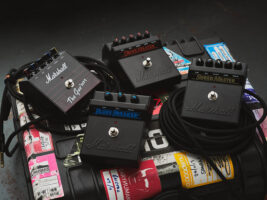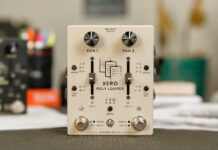
An idiot’s guide to gain-stacking – how to master the dirt pedal trick that every pro uses
The pursuit of guitar tone is seemingly endless, new pedals arriving on the scene that rehash (in)famous sounds and circuits, albeit with their own unique stamp on it. But if you look at the pedalboard of practically any famous guitarist you can mention, you’ll likely see not one dirt pedal but several – and often they’re all on at the same time.
This is because there’s a certain magic that happens when you run one circuit into another – it clips and shifts the tone in certain ways that wouldn’t be possible going direct, and sometimes the results are greater than the sum of its parts.
READ MORE: The best effect pedals for all styles and budgets
This is what’s known in the guitar world as ‘gain stacking’ and it’s become an incredibly popular way of getting the best out of your tone. But what’s actually going on here? Well, let’s see if we can break it down…
Different pedals do different things to our presence, frequency response and dynamics, and as such they’ll affect how our tone arrives, and clips, at a distortion or overdrive stage. Do you want a cleaner, more refined and crisp drive sound arriving at a dirtier pedal, or do you want overdriven, gritty tone to be sculpted by a cleaner circuit after the fact?
The way distortion clips the signal can be drastically different and is dependent on what part of the frequency spectrum hits that threshold of distortion first. An overly bright tone might have the attack and crispness subdued as the higher frequencies might be distorted first, and the same is true for mids and lows.
Similarly, drastic EQ changes might allow us to distort those highs, for example, without the mids and lows clipping. In this sense, stacking pedals to clip, distort and drive differently is a form of multi-band processing. A little aside as we are discussing gain stacking here, but EQ pedals are a great way to utilise this!
If you’ll indulge me further, I spend a lot of time as a music producer encouraging bands to pursue their own sound. We all want to sound like those who inspire us, but there’s a few reasons that it’s really important for us to also sound unique. Firstly, replicating a sound or tone can really date your music, either recorded or live, and it’ll easily get lost in the mire of countless other bands.
Secondly, it’s difficult, nigh impossible, to recreate a tone exactly, and clients and myself are often left focusing on what a sound isn’t, rather than what it is. Finally, and possibly most important of all, is that no one can sound like you, and that’s what makes your sound (and the sounds of our heroes) really cool. Pull influence from everywhere you can, but remember that the sum of all parts is what makes something unique, so throw all those sounds in a melting pot and see what you come up with.
What pedals are good for gain stacking?
A few common tone stacking options are the Ibanez Tube Screamer and Way Huge Swollen Pickle drives, used to shape tone before another drive is used for the main drive. The Tube Screamer, usually a TS9 specifically, tightens up the sound by subtly rolling off low end for a more focused attack and less mud. Without pushing the gain, this can be a great option for tightening tone before it hits another drive.
The Swollen Pickle does a similar job but in the opposite fashion, it bolsters the tone, adding heft and weight to it, even without touching the gain. Again, this can be used before another drive for a totally unique sound. Pedals that affect dynamic and presence are a great candidate for this kind of work, so things like the Boss Blues Driver, MXR Micro Amp+ or EHX Soul Food are all pedals that come immediately to mind.
Series vs Parallel Gain Stacking
Mostly when players talk about gain-stacking they’re talking about doing it in series – running one pedal into another, with the signal from one circuit being fed into the next. However, there is another option – you can run those drives in parallel (with each pedal in an independent loop in your chain), and then blend them together after the fact.
This is, of course, much tricker to do in a live environment than a studio. It’s easy enough to blend the sound of multiple amps or gain pedals together in a mix, but to do it live you’ll need a bit more thought.
The Boss LS-2 Line Selector is one solution, as is the EHX Switchblade and Earthquaker Swiss Things. These pedals boast the ability to send and receive two loops at a time, summing and blending them at output.
For example, the LS-2, when set to ‘A+B Mix’ mode, could be used to loop one drive into Loop A, another into Loop B, blended independently to taste before being summed at the pedal’s output and moving onto an amp. This makes more extreme pedals like fuzz and HM-2 style pedals entirely more usable to every guitar player.
For example, the HM-2, while often used at extreme settings, imparts a drastic EQ curve as well as some pretty wild distortion to your tone. The iconic ‘chainsaw’ signature can be blended in a little (or a lot!) to taste, and when combined with another drive, adds that chuggy, driving energy to whatever other drive you have in the second loop.
Or maybe you love the sound of something like a RAT, the aforementioned HM-2 or a fuzz, but it’s just too much. These line selector/mix pedals allow you to blend in those drives, and simply loop one side back on itself, allowing you to use these as a wet/dry blend, for a clean tone alongside whatever drive you decide on.
Much like the rabbit hole of opinions on pedal order on your pedal board, stacking gain is about listening for the signature that each stage imparts. Some offer heaps of gain on tap, but their subtle shift to dynamic can help refine your tone before a different distortion, summing to something new and wonderful.
Some pedals benefit from a bit of nip and tuck after they add gain, and some work best blended in with your clean sound, adding a hint of grit but retaining the clarity that your hands and pickups work so hard to manifest.
Different pedals are great for a variety of sounds, but combining them, blending them, looping them and stacking them are where really unique sounds begin to appear, and unique tone is the coolest tone of all. Get stacking!
The post An idiot’s guide to gain-stacking – how to master the dirt pedal trick that every pro uses appeared first on Guitar.com | All Things Guitar.
Source: www.guitar-bass.net













